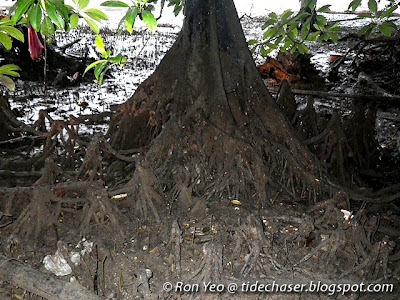The Tumu (Bruguiera gymnorhiza) is a nationally common mangrove tree from the family Rhizophoraceae.
It is commonly found in most, if not all, the mangrove forests of Singapore. It is usually found nearer to the landward side of mangrove forests, and grows best on well-aerated soil, though it can also be found growing in muddy areas.
The trunk is dark grey or brown in colour with numerous lenticels for gas exchange. Mature plants may have buttress roots at the base of the trunk. The roots radiating from the tree somewhat loop above and below ground, forming knee roots. These roots help the plant breathe air, which is scarce in the waterlogged soil. The roots spread over a wide area to help stabilise the tree on the unstable ground. Like other mangrove species from the family Rhizophoraceae, B. gymnorhiza relies on its roots to exclude salt from entering the plant through a process called ultrafiltration.
It has simple, opposite leathery leaves that are elliptic with pointed tips, clustering towards the end of the branch. The stipules are often reddish in colour.
The flowers are large, and the calyx ranges from pinkish (or even whitish sometimes) to bright red (especially under sunny conditions). The petals are white but turn brown very quickly. The big flowers with the bright colours attract birds for pollination.
The petals have 2-3 white bristles at the tip of each petal lobe, and one conspicuous bristle in the notch.
Vivipary is observed in this plant, as with the other mangrove species from the family Rhizophoraceae. This is a condition whereby the embryo grows and break through the seed coat and the fruit wall while still attached to the parent plant. Hence, the thick and cylindrical structures seen hanging from the trees are the seedlings, not fruits. The calyx usually remains pink or red.
However, in shady areas and depending on the other environmental conditions, the calyx may be greenish, yellowish or even brownish. The seedling is dispersed by water. It floats horizontally for a few weeks, during which the root (lower part) will absorb water and become heavier, eventually causing the seedling to tip and float vertically. As the tide goes down, the vertically-oriented seedling will sink into the mud or other suitable substrates. Most of the seedlings, however, end up being washed ashore or eaten by animals.
Albino seedlings may occur when there is pollution. These seedlings can be yellowish or pinkish instead of the usual greenish colour. Similar conditions can be observed in the other species from the family Rhizophoraceae.
The hypocotyl is peeled and boiled before they are eaten. The hard, red wood is used for making charcoal and building house posts, furniture and rafters.
References
- Chong, K. Y., H. T. W. Tan & R. T. Corlett, 2009. A Checklist of the Total Vascular Plant Flora of Singapore: Native, Naturalised and Cultivated Species. Raffles Museum of Biodiversity Research, National University of Singapore. Singapore. 273 pp.
- Giesen, W., S. Wulffraat, M. Zieren & L. Scholten. 2006. Mangrove guidebook for Southeast Asia. RAP Publication 2006/07. FAO Regional Office for Asia and the Pacific & Wetlands International. Bangkok. 769 pp.
- Ng, P. K. L. & N. Sivasothi. 1999. A guide to the mangroves of Singapore 1 : the ecosystem & plant diversity. Singapore Science Centre. Singapore. 168 pp.
- http://www.mangrove.my/page.php?pageid=mangrove

No comments:
Post a Comment